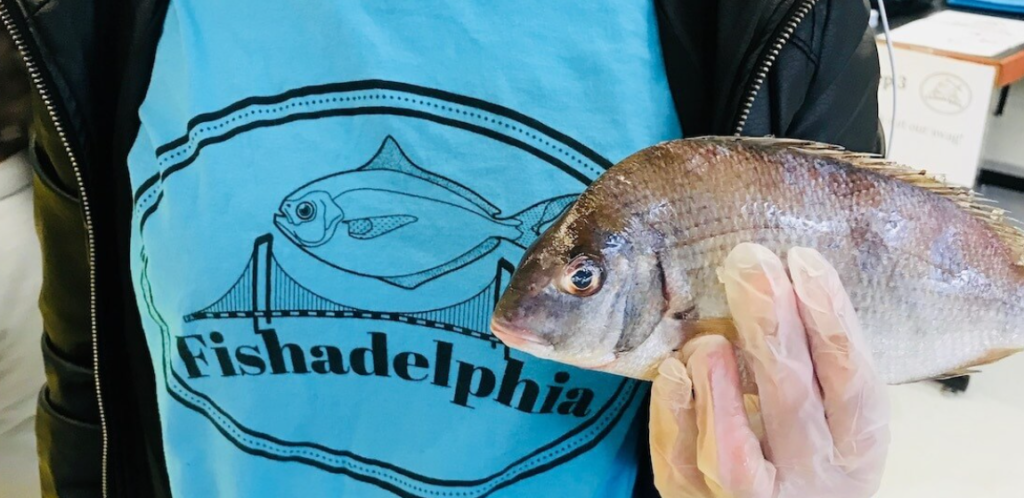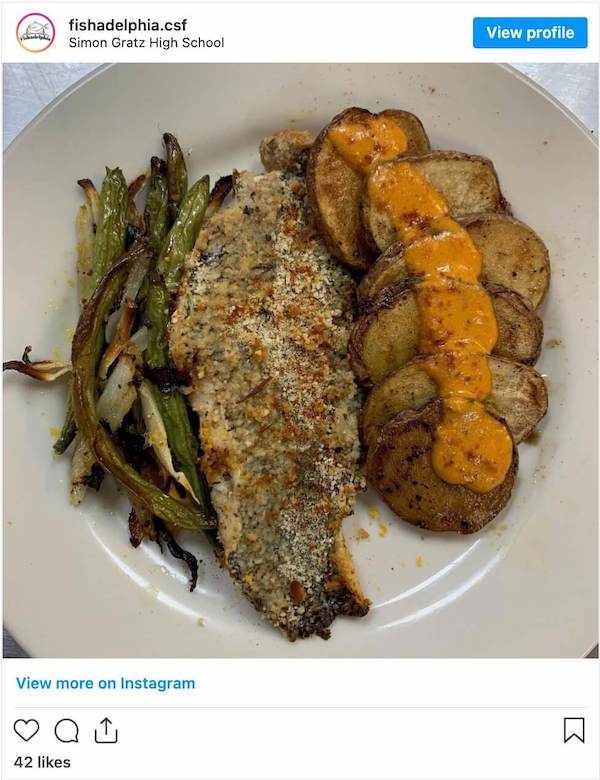
Fishadelphia
The Philadelphia Citizen
by Maddy Sweitzer-Lamme
At a local seafood conference in 2016, marine scientist Dr. Talia Young heard a complaint that’s common in the seafood industry: Americans only know how to eat cod and salmon filets—and we need to teach them how to eat other kinds of fish.
“I was like, You’re just not talking to the right Americans,” she says.
That moment six years ago sparked a realization for Young: local seafood was not being marketed to some of the communities in the United States that she thought were likely to be most interested in it. Young, who is Chinese-American, wanted to find a way to connect the Black and Asian communities she had grown up around to local seafood.
“I was the type of middle school kid that was in the environmental club and put on plays of The Lorax and tried to convince people not to use straws,” Young remembers. “I got interested in fish because fish are a place where you get to talk about people and the environment in ways that are intuitive and easy for people to think about.”
“I got interested in fish because fish are a place where you get to talk about people and the environment in ways that are intuitive and easy for people to think about,” Young says.
For four years, she had taught science classes to grades 9, 10 and 12 at Mastery Charter Schools in Philly—she loved working with students, and in the schools saw an opportunity to connect with exactly the populations she wanted to give better access to local seafood.
“I thought it would be really cool if I could work with a bunch of young people to connect economically and racially diverse eating communities in the city with rural fishing communities,” she explains.
So in 2019, she launched Fishadelphia: a student-run seafood subscription program that sells oysters, clams, porgy, skate, bluefish and more from the Jersey Shore to customers in Philadelphia.
Young works with George Mathis, a third-generation clam farmer from New Jersey, who helped her connect with fisheries on the Jersey coast and drives the seafood to the host schools, Simon Gratz near Hunting Park and Mastery Thomas in Lower Moyamensing. During study hall, the students weigh and pack it for customer pickup.
Customers commit to buying fish from Fishadelphia annually, seasonally or weekly, choosing between blue or orange club memberships. Blue club members receive between 1 ¼ pounds of whole finfish or shellfish each week, while orange club members get a smaller volume of filets or shellfish. There’s also a purple club for kosher members that skips the shellfish.
Prices are sliding scale, costing anywhere from $12.50 a week for a community membership for low-income members, to $50 a week for sustainer members, which supports discounted memberships as well as educational programming. Pick-ups happen at 20 locations every Wednesday.
What started with a handful of students selling seafood to mostly their parents and direct community has grown to include two schools and a network that brings local seafood to pick-up spots all over the city and suburbs.
From schools to families to communities
Young started out by tapping her connections at Mastery Charter School, who were happy to have her back. The administration agreed to let her run an after-school program at the Thomas Campus in the Lower Moyamensing neighborhood of South Philly, which serves largely Black, Hispanic and Asian students grades 7 through 11. That first semester, Young ran a series of focus groups to see what types of seafood students’ families might be interested in buying and at what price.
That fall, she recruited Tasha Palacio, a former student of hers who was walking dogs at the time, to help her run the program. She got a few grants to get them started; today, the program is funded in part by grants from NJ Sea Grant and the NOAA Saltonstall-Kennedy program. “I thought it was kind of weird,” Palacio remembers, “but I was a pescatarian for a long time, and I really love working with kids, so I said yes. But I wasn’t really sure it would work.”
Together, Young and Palacio built a website, made some flyers and began with 25 subscribers who would pick up fish each week at the school. That first season, most of the customers were family of the students, but the community quickly grew.
Wenxin Weng, one of the original students from the first semester at Thomas, remembers creating a WeChat group to connect Fishadelphia with the Chinese community in South Philly.
“When we first started, it was just my mom and a couple of friends,” Weng says. “But my brother was in elementary school near Thomas, and we would go to the library every day after school—we met a lot of other Chinese families who were interested, so I would add them to the WeChat.”
Weng was a junior when Fishadelphia started. Today, she’s an undergraduate at Drexel, and still works part-time for Fishadelphia, sharing weekly fish availability in that same WeChat group, which now has more than 140 members.
Young remembers another student who helped them grow their customer base early on—she was deeply embedded in the Burmese Christian community of South Philly.
“There’s a lot of food programming out there that’s like Poor people don’t know anything, and we have to teach them all the things,” Young says. “But a lot of the people who we sell to know more about seafood than I’m ever going to know in my entire life, and our goal is to make it possible to have access to that and then share that expertise.”
“She would just take a bunch of fish home,” Young said. “And then come back the next day with a bunch of cash.” The access students created for specific communities through the city proved to Young early on that operating out of schools had been a good idea.
In early 2019, they launched a pilot program at Simon Gratz High School near Hunting Park in Philadelphia, whose population is more than 90-percent Black. By the time the pandemic hit, they were beginning to realize the demand for their product was much larger than just the communities around the two schools.
As part of the weekly sales, some dedicated customers who lived further from the schools, including Clark, began hosting coolers: Each week they’d pick up a cooler packed with fish orders for folks in their neighborhoods, which would sit on their porches for other members to pick up from. When schools shuttered during Covid, the cooler system became the main form of distribution across the city, which allowed the network to grow quickly.
These days, customers host coolers all over the city, serving fish to more than 300 people who buy into Fishadelphia for seasonal shares, which have the option to be subsidized for customers who qualify for SNAP.
The shares are different from week to week, rotating between oysters (they work with three different oyster farms), clams, scallops, skate, dogfish, yellowfin tuna and more—all sourced from one of about three different docks on the Jersey Shore. The fish is filleted by The People’s Kitchen; Young says she’d love for the kids to learn to process, but she also loves that they all have 10 fingers.
With each share, Fishadelphia includes a newsletter with information about the fish, where it was caught and by whom, a word search and recipes like monkfish in tomato-garlic sauce, pan-fried skate wing and whole fried porgy.
“I’ve fulfilled a lifelong ambition to learn to open oysters myself,” says Conna Clark, a Mt. Airy resident who started buying fish in 2018 after her daughter, who lives in South Philly, told her about the organization. “I’d never had skate outside of a restaurant, and now I know how to cook it.”
Every week, students share customers’ photos of their creations to the Fishadelphia Instagram, selecting a winner. Submissions have included fried porgy, oyster banh mi and pan-fried fluke with fried rice.
Selling at the elementary school for a reason
Since 2018, the Fishadelphia team has grown to include one full-time staff member, three part-time adult employees, five program alumni who work part-time, and a whole host of students who are now back in person running fish stands every other week. The students also do social media, pack fish and create the weekly newsletter. Students start as volunteers, working for school credit; after their first semester with Fishadelphia, they’re paid for their time if they choose to stay on.
“I think the kids are pulled in by the idea of entrepreneurship and the idea of making money,” Palacio says. “But then it becomes a lot bigger than that. We’ve become a really close community. The seniors help mold the 10th graders, and help them with their resumés and create the community in the club, and watching that is so special.”
The team’s next big goal is to hit 500 customers, at which point they’ll break even and begin turning a profit. Until then, they’re supported by grant funding, but some of their ideas will have to wait until they’ve hit that point.
“We have a slogan right now: no new projects. We just have a lot of dreams,” Young says.
“We have a slogan right now: no new projects. We just have a lot of dreams,” Young says. For one, they’d like to create a program that would help other schools create their own version of Fishadelphia. They’d also like to bring back fish trucks, a now-defunct tradition in North and West Philly, where a truck would drive through neighborhoods and sell fish. There’s also talk of hosting a multicultural filet workshop, where all the cooks they sell to could meet with fishermen, and exchange knowledge about different cultural traditions around cutting and preparing fish.
“There’s a lot of food programming out there that’s like Poor people don’t know anything, and we have to teach them all the things,” Young says. “We have some people who don’t know much about seafood, and they want to try it. But a lot of the people who we sell to know more about seafood than I’m ever going to know in my entire life, and our goal is to make it possible to have access to that and then share that expertise.”
Even as they grow, Young says the choice to be based in schools is a strategic one and is foundational to what they do.
“People are often like you should be selling at the food co-op,” she says. “And we’re like No we’re actually selling at the elementary school down the street from the co-op for a reason, because even though they’re locationally not that different, they feel like really different places and they offer different kinds of safety for different kinds of people, and that’s the most important thing for us.”
